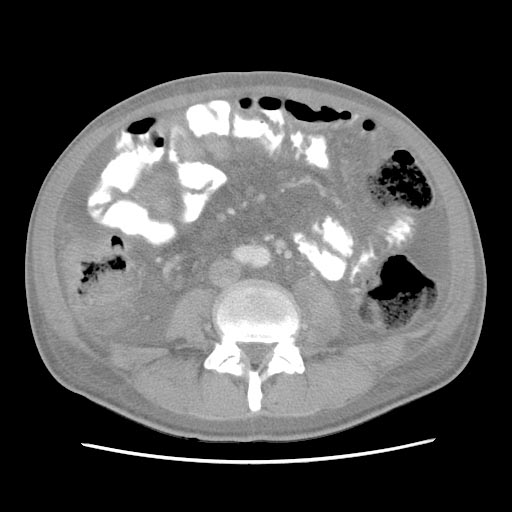Anasarca
| Anasarca | |
 | |
|---|---|
| CT scan showing generalized edema of skin | |
| ICD-10 | R60.1 |
| ICD-9 | 782.3 |
|
Anasarca Microchapters |
Editor-In-Chief: C. Michael Gibson, M.S., M.D. [1] Associate Editor-In-Chief: John Fani Srour, M.D.
Synonyms and keywords: Generalized edema, generalized swelling, leucophlegmatia
Overview
Anasarca is a medical symptom characterized by widespread swelling of the skin due to effusion of fluid into the extracellular space. Anasarca is often due to either congestive cardiac failure, liver failure (cirrhosis of the liver), renal failure/disease, or the other diseases listed below. Plant-derived anticancer chemotherapeutic agents, such as docetaxel, cause anasarca through a poorly understood capillary leak syndrome.
Complete Differential Diagnosis of the Underlying Causes of Anasarca
(In alphabetical order)
- Acute renal failure, especially oliguric renal failure with fluid retention
- Allergic reactions, only systemic severe allergic reactions with associated capillary leak
- Angioedema, rarely, when it is severe and generalized
- Burns (generalized severe burns can result in Hypoalbuminemia and capillary leak)
- Calcium channel blockers usually cause localized edma and not anasarca
- Capillary leak syndrome
- Cardiac tamponade resulting in heart failure and generalized edema
- Chronic kidney disease (advanced stages with fluid retention)
- Constrictive pericarditis with associated heart failure
- Cor pulmonale resulting in right heart failure
- Diazoxide usually cause localized edma and not anasarca
- Corticosteriods
- Dilated cardiomyopathy
- Docetaxel usually cause localized edma and not anasarca
- Eclampsia (severe eclampsia)
- Effusive-constrictive pericarditis with associated heart failure
- Estrogens
- Fludrocortisone
- Glomerulonephritis
- Haemolytic disease of the newborn
- Heart failure
- Hepatic cirrhosis
- Hereditary angioedema in severe cases
- Hypertrophic cardiomyopathy
- Hypoalbuminemia
- Hypoproteinemia
- Hypothyroidism (advanced untreated hypothyroidism)
- Idiopathic edema
- Increased capillary permeability
- Increased interstitial oncotic pressure
- Interleukin-2 therapy
- Kwashiorkor
- Lymphatic obstruction usually cause localized limb edema unless very proximal
- Malnutrition
- Malignant ascites is usually associated with lower extremities edema
- Minoxidil usually causes localized edema to the lower extremities
- Nephrotic syndrome
- Nonsteroidal antiinflammatory drug causes localized edma
- Ovarian hyperstimulation syndrome
- POEMS syndrome
- Portal thrombosis causes lower extremities edema
- Pramipexole
- Pregnancy
- Protein loss
- Protein-losing enteropathy
- Reduced albumin synthesis
- Refeeding edema
- Restrictive cardiomyopathy
- Severe inflammation or sepsis
- Sodium overload
- Thiazolidinediones
- Trauma (severe trauma)
- Tricuspid stenosis
- Tropical sprue
- Venous obstruction usually causes localized edema in the limb
- Water overload
- Yellow nail syndrome
Complete Differential Diagnosis of the Causes of Anasarca:
(By organ system)
Diagnosis
CT images demonstrate diffuse anasarca
Treatment
The treatment of anasraca depends on the underlying cause. It involves the use of diuretics in cases related to heart failure or kidney disease. The latter may require hemodialysis especially if there are signs or symptoms of uremia. In cases of severe burns resulting in hypoalbuminemia and capillary leak, admission to a burn unit, volume and electrolyte replacement, and adequate nutrition is of paramount. Withdrawal of the offending drug is critical in drug-induced anasarca. The use of diuretics, paracentesis, and adequate nutritional supplementation is needed in anasarca secondary to hepatic cirrhosis. Profound hypothyroidism requires thyroid hormone replacement. Protein malabsorption syndromes require the identification of the underlying disease process and adequate protein supplementation.

